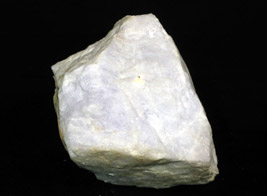
Locality: Palermo Mine, N. Groton, NH
Specimen Size: 6 cm massive chunk of montebrasite
Field Collected: Marge Holland between 1940 and 1950
Catalog No.:
Notes: Purchased as "ambligonite" at 2009 Gilsum Rock Swap. EDS analyzed and determined to be montebrasite. Many old Palermo species lists include ambligonite, but a confirmed ambligonite specimen is unknown to the author (Tom Mortimer).
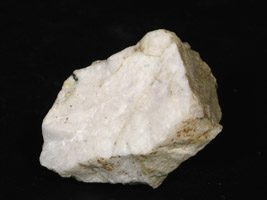
Locality: Chickering Mine, Walpole, NH
Specimen Size: 3.5 cm massive chunk of montebrasite
Field Collected: Tom Mortimer
Catalog No.:
Notes: Montebrasite can be quite difficult to distinguish from feldspar on a mine dump.

Locality: Palermo Mine, N. Groton, NH
Specimen Size: 0.7 mm montebrasite crystal impaling a quartz crystal
Field Collected: Bob Janules
Catalog No.: u163
Notes: * Montebrasite crystal has red oxide coating.
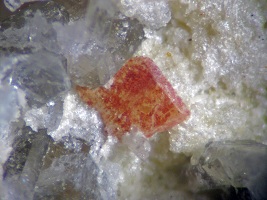
Locality: Palermo Mine, N. Groton, NH
Specimen Size: 1 mm montebrasite crystal
Field Collected: From crate of Palermo rocks given by Bob Whitmore
Catalog No.:
Notes: Montebrasite crystal has red oxide coating. Specimen has been cleaned for 10 minutes in ultrasonic with Iron-Out.
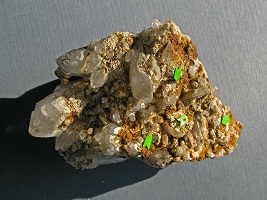
Locality: Palermo Mine, N. Groton, NH
Specimen Size: 8 cm specimen of quartz-apatite with micro montebtasite crystals indicated by green arrows.
Field Collected: From crate of Palermo rocks given by Bob Whitmore
Catalog No.:
Notes: The above micro montebrasite crystal was trimmed from this specimen. This photo is included to illustrate the host matrix for these small, rare-at-Palermo, crystals. Micro montrabrasite crystals are just visible beyond the tip of the green arrow with the red dot.
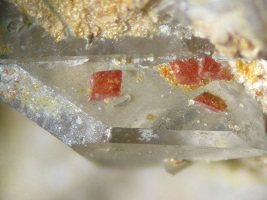
Locality: Palermo Mine, N. Groton, NH
Specimen Size: 3 mm field of view. 0.5 mm red oxide coated, rhombic-tabular, montebrasite crystals on quartz crystal.
Field Collected: Dana Jewell
Catalog No.: TBC
Notes: From a flat of Palermo rocks donated by Dana Jewel at the November, 2014 Micromounters of New England meeting. Dana collected these underground.
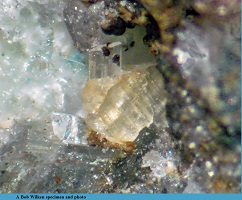
Locality: Palermo Mine, N. Groton, NH
Specimen Size: 0.3 mm clear prismatic rhombic montebastite perched on yellowish mass
Field Collected: Walter Lane material from MMNE
Catalog No.: A Bob Wilken specimen
Notes: [bw] It's amazing that such a small thing when sharp and clearly defined will come out. Other things this size come out as blobs.

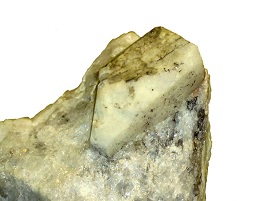
Locality: Turner Mine, Marlow, NH
Specimen Size: 11.3 x 11.3 cm specimen, two views
Field Collected: A Friend
Catalog No.:
Notes: ID by collector

Locality: Turner Mine, Marlow, NH
Specimen Size: 11.2 cm specimen
Field Collected: A Friend
Catalog No.:
Notes: ID by collector
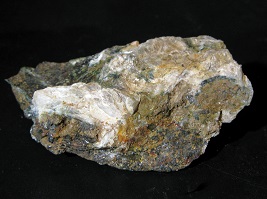

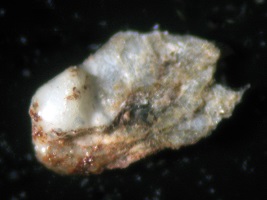
Locality: Palermo Mine, N. Groton, NH
Specimen Size: 5 cm specimen with pearly white montebrasite cleavages
Field Collected: From a crate of Palermo phosphate rocks gifted by Bob Whitmore
Catalog No.: 2007
Notes: This brittle mineral is fusible (third photo), a distinguishing characteristic of lepidolite, which was my initial guess as to what the species was.
Lepidolite is not listed for the Palermo Mine in Whitmore & Lawrence's book, The Pegmatite Mines Known as Palermo.
Other typical Palermo species are present on this specimen including triphylite, ferrisicklerite, siderite, strunzite and quartz.
Palermo is a lithium pegmatite, so lepidolite did not seem unreasonable.... and this piece is somewhat un-remarkable.... so perhaps this species had been overlooked. Speaking with Bob Whitmore, June 2016, he stated lepidolite had never been reported from Palermo, and doubted my ID. A polished grain EDS analysis, BC80, indicates a aluminum phosphate, (the small silicon peak is believed to be a contaminant). Montebrasite is an aluminum phosphate with good cleavage. Members of the lepidolite series require both potassium and fluorine, neither of which were detected in this analysis.
George Adleman acquired a Raman spectrum from this 2007 specimen. This analysis strongly supported the montebrasite identification. The first (scan 318) and third trace (scan 319) are from this specimen. The second trace is the RUFF reference trace.